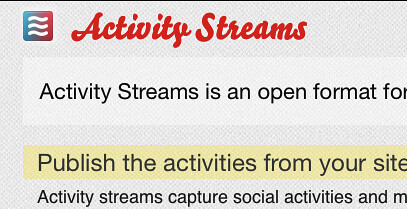Action Branding is the concept that brands are the sum of their actions.
— Extending this concept to personal brands and organizational brands, action branding helps individuals and organizations demonstrate, and thus authenticate, the character, values and purpose they claim to have.
— Social media creates opportunities for individuals and organizations to track, organize and display their ‘activity streams’ so that others can construe the person or organization’s identity from their actual behaviors.
Too much of what constitutes a “brand” is fake.

Most of a product’s brand is a fiction. It’s a social construction. You learned that in Marketing 101.
Brands are claims built on top of a product’s material features and attributes. Brands are claims that marketers want us to believe; when we believe these claims we make the claims and the brands they compose more or less “real”.
Still, in a consumerist culture, we’re generally aware and okay with the idea that our product brands are created largely to sell products, and not so much to reflect the inherent qualities of the product itself.
Personal Brands and Organizational Brands
When we apply the concept of “brand” to individuals and to organizations, we can run into trouble. When we replace concepts like “reputation” and “image” with “brand”, we highlight the question of whether the claims that compose these brands are authentic or not.
We know that people and organizations are “real”, but we are left to wonder whether their brands — their claims about “who they are” — actually represent what defines them. This question of how ‘real’ these brands are gets raised over and over on social media.
Social media provides individuals and organizations with a huge array of places and formats for telling us who they are. On Facebook, Twitter, blogs, and more, we use profile pictures, self-descriptions, “likes” and dislikes, and other forms of self-presentation to claim and declare who we are.
How do we know whether these declared personal brands and organizational brands are real?
To figure out whether claims and declarations are real, we try to authenticate and substantiate these claims.
Authenticating is the process of establishing the origin or ownership of a quality to confirm that this quality exists. We want to know where that quality comes from, as a way to make sure that it is inherent in the person or organization, rather than just pasted on it.
Substantiating is the process of finding the substance, the material support, behind a claim about identity. We want proof that this quality exists.
We prove who we are by what we do.
When we want to authenticate or substantiate an individual or organization’s identity claims, we look at their actions. And, when individuals and organizations want to make their claims real, they turn to behavior to show us.
Just think of the words that social psychologists use to describe how we create and substantiate our individual identities: We express. We demonstrate. We perform. We enact.
In short, we behave like the people we say we are.
Social Media => Activity Streams

Social media creates new opportunities for us to demonstrate, track, aggregate, and display these actions, through our online “activity streams”.
A person’s activity stream, technically, is the confluence of many different sequences of activity-related data that a person publishes on an assortment of different work, social and personal platforms. When/if aggregated, either formally by a service or informally by someone simply paying attention to that individual, that activity stream tells us what you’re doing, often with whom, and often why, giving us a sense who you are based on what you do.
Activity Streams => Action Branding
Using activity streams made visible on social media, individuals and organizations can engage in “action branding.” They can create a more substantiated, authentic ‘brand’ by building a sense of who they are that is crafted as much by actions as by declarations and claims.
The actions people see on our activity streams, as captured by different media platforms, provide information for substantiating and authenticating identity claims.
- On platforms like Twitter, individuals can share what they’re thinking, offer their reactions, recommend resources, and engage in conversations with others in ways that demonstrate what they are paying attention to and even what they’re doing.
- On platforms like Hashable, individuals can track and then display who they’re meeting with, what they’re doing, and why, using activity hashtags (e.g., #meeting) as well as project hashtags (e.g., #morevoices).
- On other platforms like IfWeRanTheWorld and MyImpact.org , individuals can direct, organize and display project-related micro-actions where they are actively contributing support for cause they care about. Both of these sites are intentionally designed to allow individuals and organizations to display their actions to others with a composite personal profile as an as an activity stream.
Action Branding Defined & Demonstrated

Action branding as a business tool is the brainchild of Cindy Gallop, CEO & Founder of IfWeRanTheWorld. Cindy drew on her insights about what’s missing from traditional approaches to branding to build a social media platform that aggregates individual and organizational actions that advance values-driven projects, IfWeRanTheWorld creates a place where individuals and brands (and the organizations that own the brands) can demonstrate the attributes and values that they claim to have, by organizing, recording and displaying the actions that they take to make these claims real.
As Gallop describes action branding:
“It’s not about saying but doing. It’s not about telling but being. It’s communication by demonstration.”
This business insight is supported not only by basic social science about identity and image creation, but also by our common experience of presentation and authentication.

- An organization’s “brand” or identity or image is anchored in the human attributes of organization members, in the organization’s collective values & goals, and in that organization’s routines and practices.
- An individual’s “brand” or reputation or image is anchored in his or her human attributes, values & goals, ways of being, and actions.
For individuals and organizations, the authenticity challenge is to demonstrate that your claims about who you are are borne out by the actions that you take.
Action branding holds us to a higher level of accountability, and brings along with it a firmer sense of authenticity.
See also:
Activity Streams: Moving Beyond Event Aggregation by Mike Gotta
Datum iPhone App turns your daily routines into visual report cards FastCompany
Authentic From the Start-Up: 4 Tips from Cindy Gallop and IfWeRanTheWorld
Authentic Student Entrepreneurs: Embedding Personal, Product and Organizational Brand
When the Organization Wears its Brand
Images: Tracks from Doug McG. Fingerprints (page 12-13) -…from atibens Prints from qmnonic

 I am an organizational consultant, change advocate, and organizational identity/reputation scholar with a PhD in leadership & organizations. I research, write about, and consult with organizations on the relationships between organizational identity, actions, and purpose. I teach Technology Management, part-time, at Stevens Institute of Technology.
My current research focuses on how social technologies in the workplace can drive organizational change, generate meaning, and catalyze purpose. See the
I am an organizational consultant, change advocate, and organizational identity/reputation scholar with a PhD in leadership & organizations. I research, write about, and consult with organizations on the relationships between organizational identity, actions, and purpose. I teach Technology Management, part-time, at Stevens Institute of Technology.
My current research focuses on how social technologies in the workplace can drive organizational change, generate meaning, and catalyze purpose. See the 
Comments on this entry are closed.